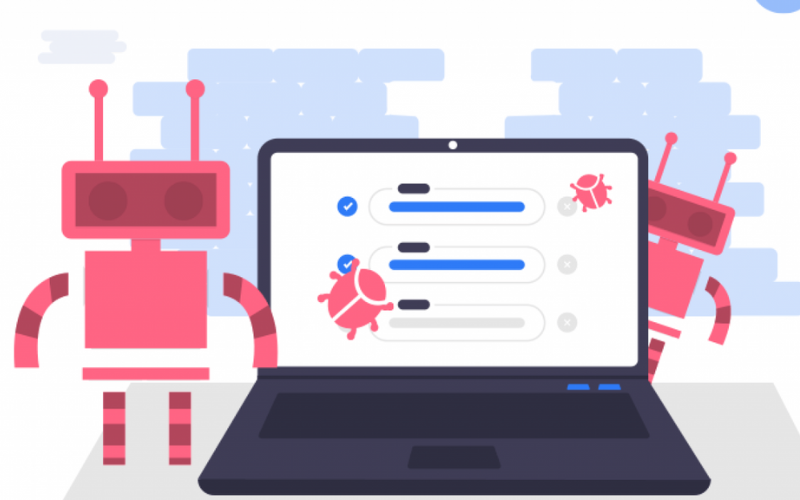If you have a website for
business, you should understand what bots are, how they may access it, and what
they can do (deliberately or unintentionally) to thwart your marketing efforts
on the internet.
Despite the fact that there
are many different kinds of bots, they all serve diverse objectives and account
for almost half of all website traffic worldwide.
For example, good bots will
assist you with crucial services, whilst bad bots may attempt to significantly
harm your company.

Therefore, it’s crucial to
know how to block bad bots and prevent them from harming your website.
How
does a bot work?
As stated, bots can be
helpful for a variety of tasks, including indexing for search engines and
enhancing client experiences.
Also, they might be hostile
and harm your website or other online presence. Some bots are designed to crawl
websites and steal data, including passwords, personally identifiable
information, or other sensitive information.
They have the ability to
launch malicious assaults on computers, websites, and other targets.
They can be used to increase
online interaction as well. This could take the form of spamming a page or
forum with comments, increasing sales or popularity of something to pique
interest, increasing social media activity to increase views, or using other
"gaming" techniques.
There are various
indications that bots have visited your website:
- excessive blog or other page comments
- excessive or sudden
high bounce rates on a particular page
- comments that don't
seem to be human-generated or readable
- comments with obvious
spam or excessive linking
- a sudden increase in
newsletter sign-ups or other forms of email sign-up
- comments with log-in
attempts from unknown sources, or any other activity that seems suspicious
15
methods to prevent bad bots
We need to pause for a
moment and define a bot before getting into the specifics of what they can do
as well as how you can stop them.
A software script that
repeatedly processes data is known as a bot. They become a fellow participant
in the online world we interact with because of their repetition and data
interaction.
It can resemble trying to
erect an invisible wall to keep attackers out when you try to prevent bots from
accessing your website.
1.Determine the issue
You are very concerned about
bots and want to know how they are hurting your website. It's always crucial to
check what's happening on your site before moving further.
Do you constantly have bot
problems, or is there merely a spike in activity?
Hence, if you suddenly
learned that a swarm of malicious bots is infecting your website, you need to
take action right away to fix this issue or else your site won't work properly.
After you have identified
the issue, it’s time to begin taking the other steps necessary to block bad
bots.
🔘 Related: Tips for Enhancing Website Security in Your Development Process
2.Stay up to date
Keep up with the most recent
releases for your website and all of its integrations as one of the methods
to prevent bad bots. Make sure you are up to date on the releases of the
website CRM platform you choose to use.
If you use WordPress, for
instance, you should make sure that your theme and plugins are up to date.
Keeping updated has its
benefits. First, older versions may be used by bots to access a system.
Additionally, platforms have an incentive to offer their clients secure
products.
The most recent improvements
might include enhanced security measures and bot blocker choices.
3.Inactive bot user elimination
Similar to how a list of
email subscribers and inactive users should be frequently checked and anything
that doesn't meet the needs of the user should be removed, the same remarks
should be ignored on a regular basis.
Bot users that managed to
circumvent the sign-up authentication security level are easy to find and
remove. But it's also crucial to remove accounts that haven't been used in a
while in order to block bad bots.
Yet, inactive accounts often
contain bots or are more vulnerable to malicious bots later on.
In general, malicious bots
attempt to take over existing accounts rather than continuously creating new
ones and hiding them.
4.Avoid using older browser versions
One of the other methods
to prevent bad bots from accessing your website is to prevent earlier
versions of your browser from visiting it. You can request that visitors see
your website for business using more recent browsers.
This technique pushes all
users to update to newer versions of their browsers and stops malicious bots
from accessing your website.
You must update your site's
.htaccess file when switching to a more recent version of the browser, but if
you don't have the necessary technical knowledge, it's preferable to employ a
web developer.
5.Check your APIs
You might already have a ton
of API integrations connected to other online platforms, especially if you've
owned your website for a while.
APIs may be a point of vulnerability
if you've permitted the API integration to connect and share data on your site.
Also, you may audit each
plugin, API, and several other integrations. But, take into account the
following possibilities:
- Do you employ them all?
- Do you use any of the
most recent versions? If not, think about updating them.
- Do you use
high-quality goods? Make a substitute if you don't have the necessary security
preventive measures.
6.Take advantage of CAPTCHA
One of the effective methods
to prevent bad bots is adding CAPTCHA. Making ensuring that only people
can complete tasks like sign-ups, contact forms, and purchase options on your
website for business is one technique to prevent bots from engaging with those
areas.

In order to show they are
not a robot, CAPTCHA requires the user to complete a challenge or other action.
A bot won't complete this
task and proceed unless the proper action is included in their script.
But, keep in mind that there
is very little likelihood of successfully trying to stop outdated users. Most
contemporary browsers will automatically update users, making it more
challenging for users to browse the web on out-of-date versions.
7.Use sign-up authentication
A sign-up authentication can
dramatically lower the amount of bot accounts that wish to register on your
website if it uses user accounts extensively.
Typically, sign-up
authentications require a user's phone number or email address along with a
verification code. Authentication is simple for humans but challenging for
machines!
Also, it enables
administrators to determine whether new users have confirmed accounts as
accounts that have not been verified are frequently false.
8.Tagging alteration
In some cases, seeing spam
in your mailbox indicates that bots are associated with a tag that permits it.
Yet, the contact form or the about page are typically where the largest problem
lies.
Whatever you do, make sure
your contact form hides email addresses because if you don't, the bot will
quickly identify the correct email for scanning as opposed to utilizing an
external script, which is much difficult for the bot to detect.
Above all, it's advisable to
alter your email for an additional degree of security if your page lists it in
a way that a bad bot (spam bot) can easily recognize.
9.Block proxy services and known hosting providers
Many less skilled criminals
use readily available hosting and proxy services, even if the most expert
attackers switch to other, harder to block networks.
By preventing access from
these sources, you may be able to deter attackers from targeting your website,
API, and mobile apps.
10.Safeguard any access point you can
Next on our list of methods
to prevent bad bots is protecting access points. Always take precautions to avoid being
exposed to mobile apps and APIs when dealing with malicious bots.
Also, whenever it's
practical, think about transferring blocking data between systems.
11.Keep track of failed login attempts
Failure to log in is
expected, but when it happens frequently or there is a noticeable increase, you
are immediately informed of it.

Seasonal checkups won't cut
it; you need to check frequently all year round!
12.Keep an eye out for public data leaks
Credentials that have just
been stolen are more likely to still be in use. Expect malicious bots to
frequently run those credentials against your website for business when
significant breaches happen elsewhere.
13.Comment restriction
It's crucial to frequently
review any comments on your website because you may come across comments that
are harming your websites, such as spam comments with incorrect links and more.
In the event that you have
serious problems with spamming bots constantly visiting your website, you can
set up a manual comment moderation system to prevent this.
Even so, personally
moderating comments can be time-consuming, but it's the only way to completely
get rid of bots and spam.
🔘 Related: How to prevent cyber attacks
14.Purchasing a bot management tool
The majority of modern bots
are harmful, and if you want to properly block bad bots on a server or website,
you need to use the right bot management system to analyze their activity.
Look for bot management
solutions that can detect bots automatically and effectively use both ML and AI
for real-time bot activity detection.
15.Monitor your website constantly
Bot blocking is a continuous
process. You must keep an eye out for any issues with your website.
You can keep an eye out for
any of the issues mentioned above and take action to patch any openings. For a
monthly or quarterly check-in, you might want to put this on your calendar.
Keep an eye out for any
public data breaches as well. Check your website for any indications of bot
activity if you hear of any large-scale attacks.
Conclusion
We'll probably talk more
about how to block bad bots and integrate them into our marketing stack as AI
in marketing develops. Bots can enhance our digital marketing strategy and be
useful in our digital operations.
Also, they might be hostile
and target your website for business at any time. Being diligent and
maintaining an updated, clutter-free web presence are the greatest ways to
deter bots.
In this article, we
explained some of the most effective methods to prevent bad bots. If you
have more questions regarding bots and their impact, contact us now.